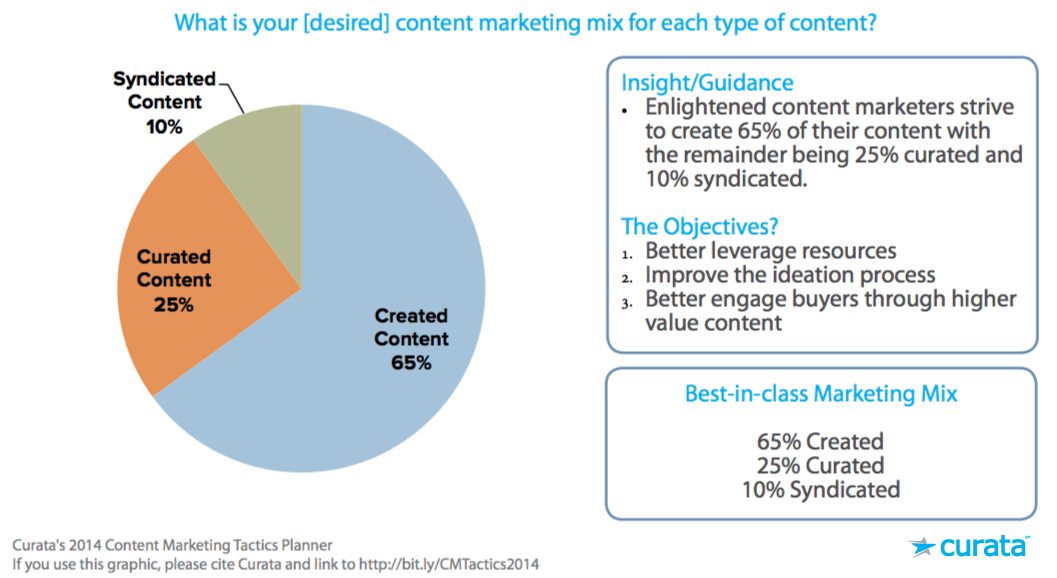How to use Content Curation
to Grow Your Online Business
by pawan deshpande
Marketers in a content-driven landscape are responsible for producing vast amounts of content, day in and day out. But most of us don’t have the time, staff, or budget to publish enough great (or even good) content. We do our best, but staying ahead of the demand is often impossible. That’s where content curation comes in.
This hands-on guide will show you how curation fills that gap, answering the following questions:
- WHY content curation is a good idea, including a look at the new Buyer 2.0,
- WHAT content curation is, and how it fits in the overall content marketing mix context.
- HOW you can put content curation to work for your brand, including a detailed, step-by-step look at what, when, where, and how to curate effectively.
- WHY you’re curating content in the first place – a full-circle look at performance, measurement, and optimization.
This guide also includes insight from over 30 content marketing experts, who each answer the question:
What’s the single most significant benefit of curation to content marketing?
executing and delivering the content and related assets that are needed
to create, nurture and grow a company’s customer base."
Why Content Curation? Why Now?
The path to purchase used to be a straightforward line from Point A (buyer need) to Point B (conversion). It was easy for marketers to guide and even control the prospect’s journey along this narrowly defined series of steps.
But, you know all that’s changed.
Today’s buyer is hyper-connected in real time via multiple devices and channels to an inexhaustible avalanche of information. This buyer isn’t waiting for you to tell him what to do next. In fact, according to Sirius Decisions, 70% of the buyer journey is completed without any sales involvement.
So, how are buyers making their purchase decisions, and – more importantly – how can you influence those decisions?
Enter Content Marketing.
Businesses are turning to content marketing, the process for developing, executing and delivering the content and related assets that are needed to create, nurture and grow a company’s customer base.
But, as more businesses jumped onto the content marketing bandwagon, it has become difficult for marketers to maintain the frequency and quality required to compete.
Content curation helps you compete effectively and efficiently, providing unique benefits critical in today’s market.
Adding content curation to your content marketing mix delivers the following benefits:
- Improve Search Engine Optimization: Curated content becomes additional indexable pages that provide more doorways into your site via search engines.
- Establish Credibility as a Thought Leader: Curated content helps you develop go-to web resources that improve your credibility and encourage visitors to trust you as the authority on your topic.
- Support Lead Generation: Curated content drives incremental site visits that increase the potential for landing quality leads.
- Streamline Lead Nurturing: Curated content is easily repurposed via newsletters, emails, and other channels to make lead nurturing simple and consistent.
- Complement Social Media & Blogging: Curated content supplements your social media publishing schedule and helps facilitate social media conversations not only with prospects and customers but also with peers.
Quick Refresher: What is Curation?
Curata’s definition of content curation is as follows:
Content curation is when an individual (or team) consistently finds, organizes, annotates, and shares relevant and high quality digital content on a specific topic for their target market.”
At its best, curation is…
- A person, not simply a computer algorithm.
- Being discerning, discriminative, and selective.
- Adding value: perspective, insight, and guidance.
- Not a one-time event or activity.
- A laser focus on your audience.
Key Points to Remember About Content Curation
- You can curate content from a wide variety of online sources, including trade publications, social media profiles, blogs, scientific journals, news outlets, and more.
- You can and should organize curated content using rich and tailored taxonomy, grouping and categorizing related content.
- You can share content with your audience via many different channels including websites, social media feeds, blogs, mobile apps, widgets, and email newsletters.
- Content curation is not aggregation, which lacks the human touch.
- Content curation is a fundamentally human process. At the center of it all is the curator—you—hand-selecting which content to share, determining which organizational method will increase accessibility and usability, and adding context and insight to aid your audience in gaining a deeper understanding of the content.
- Content curation is not content farming: a.k.a. the unethical pirating of third-party content and publishing of high-quantity, low quality content.

How Does Content Curation Fit into the Content Marketing Mix?
According to Curata data, best-in-class marketers create 65% of their own content and syndicate 10%. For the remainder they use content curation, as illustrated below.
A Step-by-Step Guide to Content Curation
There are five primary activities required for developing and maintaining an efficient, effective and ethical curation practice:
- Define your objectives
- Find your sources
- Curate by organizing and editorializing
- Share via a variety of channels and mediums
- Analyze and optimize your content curation performance
1. DEFINE YOUR OBJECTIVES
Content curation can be used externally for marketing purposes, or internally for knowledge management and competitive intelligence. This guide is focused on the marketing side, but the majority of best practices covered are relevant for any use case, so let’s examine a few other possibilities:
Marketing
Share content to inform, educate, and influence your prospects and customers, simultaneously strengthening your brand’s position as a go-to resource and industry thought leader.
Knowledge Management
Educate an internal audience—such as a team of researchers, on a particular topic.
Publishing
Build an online destination that can be monetized via advertisements or sponsorships.
Competitive Intelligence
Inform internal stakeholders about relevant news. For example, you might use curation to keep your sales team up-to-date on your competitors and industry.
Before you start curating content, ensure that you have a clear goal in mind.
2. FIND
Picking Your Topic
 Picking your topic is an essential first step in developing a successful content curation program. Unlike other parts of the curation process which are performed on a repetitive basis, picking your topic is typically something you only need to do once.
Picking your topic is an essential first step in developing a successful content curation program. Unlike other parts of the curation process which are performed on a repetitive basis, picking your topic is typically something you only need to do once.
Of course a topic can evolve over time, but you can ensure you’re starting on the right foot if you engage in proper due diligence.
The Three Elements of a Perfect Topic
There are three factors to consider when finding the perfect curation topic:
 1. Competitive Landscape: How much competition is there for this topic?
1. Competitive Landscape: How much competition is there for this topic?
2. Audience Interest: Is my target audience interested in this topic?
3. Content Landscape: Is there sufficient content on this topic for me to curate?
Ideally, you’re looking for a topic that:
• Has relatively low competition, meaning it isn’t already widely covered.
• Is of specific interest to your audience.
• Has generated sufficient content in the market for you to curate.
This topic should fall in the middle of the venn diagram. Below, I walk through three tests that help you choose the perfect topic.
TEST 1: SURVEY THE COMPETITOR LANDSCAPE:
To survey the competitor landscape, look at other sites that cover your chosen topic and ask yourself the following questions:
- Can I curate better than they can? Can you make your curation site more attractive to readers by offering greater depth of coverage, relevancy and/or consistency?
- Is there a better perspective or opposing point of view? Can you curate the same content from a different angle, highlighting a unique take on the topic?
- Can I broaden or narrow my topic? Can you use increased specificity or, conversely, greater scope of topic to increase your content’s “discoverability”?
TEST 2: SURVEY THE CONTENT LANDSCAPE
In order to create a successful curation program, you must have enough content to curate. Here are a few quick and easy ways to assess the availability of content:
- Plug your desired topic into Google News and sort your results by date to see how many articles are being created per day or week.
- Do the same exercise in Twitter, Facebook, and LinkedIn.
- Review blogs that cover your topic, either consistently or intermittently.
TEST 3: DETERMINE YOUR AUDIENCE INTEREST
Even after your topic passes the competitor and content landscape tests, the most important hurdle still remains. You have to ensure the topic is interesting to your business’s target audience. If not, your curated content will fail to capture or hold your audience’s attention. To gauge audience interest, use the following methods:
- Use the Google Keyword Planner to measure the general level of online interest in a given topic.
- Use either interviews or a simple survey to get a sample of your customers’ opinions about your topic—how important it is, whether they feel they have information on it already, what specific questions they already have.
The perfect topic will pass all three tests: competitor, content, and audience. However, curators often need to work with a topic that is not quite perfect and only passes two of the three tests.
An example of a great topic can be found on IBM’s Smarter Planet. IBM uses the site to educate professionals about smarter systems. They first surveyed their competitors and the current technology landscape before deciding that their audience (mainly IT professionals) would be interested in news about smart systems.




